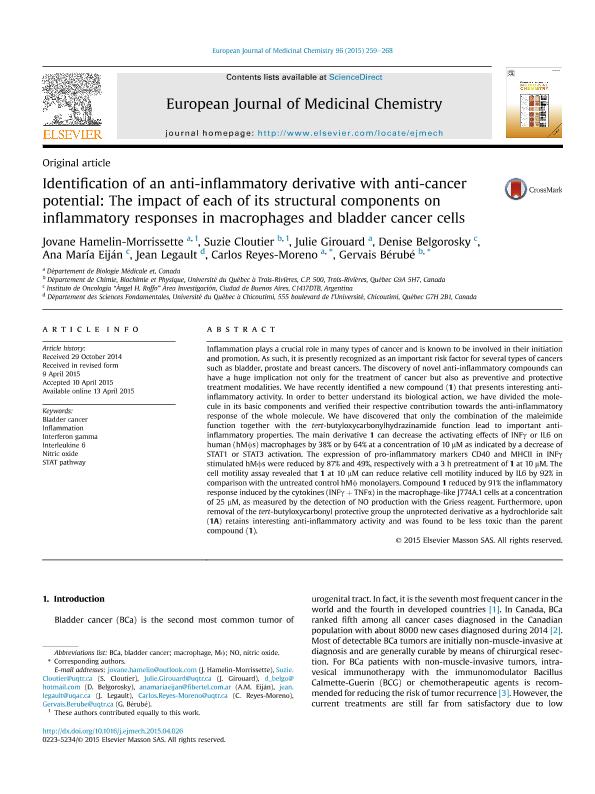Artículo
Identification of an anti-inflammatory derivative with anti-cancer potential: the impact of each of its structural components on inflammatory responses in macrophages and bladder cancer cells
Hamelin Morrissette, Jovane; Cloutier, Suzie; Girouard, Julie; Belgorosky, Denise ; Eijan, Ana Maria
; Eijan, Ana Maria ; Legault, Jean; Reyes Moreno, Carlos; Bérubé, Gervais
; Legault, Jean; Reyes Moreno, Carlos; Bérubé, Gervais
 ; Eijan, Ana Maria
; Eijan, Ana Maria ; Legault, Jean; Reyes Moreno, Carlos; Bérubé, Gervais
; Legault, Jean; Reyes Moreno, Carlos; Bérubé, Gervais
Fecha de publicación:
26/05/2015
Editorial:
Elsevier Masson
Revista:
European Journal of Medical Chemistry
ISSN:
0223-5234
Idioma:
Inglés
Tipo de recurso:
Artículo publicado
Clasificación temática:
Resumen
Inflammation plays a crucial role in many types of cancer and is known to be involved in their initiation and promotion. As such, it is presently recognized as an important risk factor for several types of cancers such as bladder, prostate and breast cancers. The discovery of novel anti-inflammatory compounds can have a huge implication not only for the treatment of cancer but also as preventive and protective treatment modalities. We have recently identified a new compound (1) that presents interesting anti-inflammatory activity. In order to better understand its biological action, we have divided the molecule in its basic components and verified their respective contribution towards the anti-inflammatory response of the whole molecule. We have discovered that only the combination of the maleimide function together with the tert-butyloxycarbonylhydrazinamide function lead to important anti-inflammatory properties. The main derivative 1 can decrease the activating effects of INFγ or IL6 on human (hMϕs) macrophages by 38% or by 64% at a concentration of 10 μM as indicated by a decrease of STAT1 or STAT3 activation. The expression of pro-inflammatory markers CD40 and MHCII in INFγ stimulated hMϕs were reduced by 87% and 49%, respectively with a 3 h pretreatment of 1 at 10 μM. The cell motility assay revealed that 1 at 10 μM can reduce relative cell motility induced by IL6 by 92% in comparison with the untreated control hMϕ monolayers. Compound 1 reduced by 91% the inflammatory response induced by the cytokines (INFγ + TNFα) in the macrophage-like J774A.1 cells at a concentration of 25 μM, as measured by the detection of NO production with the Griess reagent. Furthermore, upon removal of the tert-butyloxycarbonyl protective group the unprotected derivative as a hydrochloride salt (1A) retains interesting anti-inflammatory activity and was found to be less toxic than the parent compound (1).
Archivos asociados
Licencia
Identificadores
Colecciones
Articulos(OCA HOUSSAY)
Articulos de OFICINA DE COORDINACION ADMINISTRATIVA HOUSSAY
Articulos de OFICINA DE COORDINACION ADMINISTRATIVA HOUSSAY
Citación
Hamelin Morrissette, Jovane; Cloutier, Suzie; Girouard, Julie; Belgorosky, Denise; Eijan, Ana Maria; et al.; Identification of an anti-inflammatory derivative with anti-cancer potential: the impact of each of its structural components on inflammatory responses in macrophages and bladder cancer cells; Elsevier Masson; European Journal of Medical Chemistry; 96; 26-5-2015; 259-268
Compartir
Altmétricas



